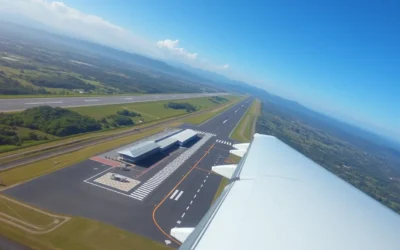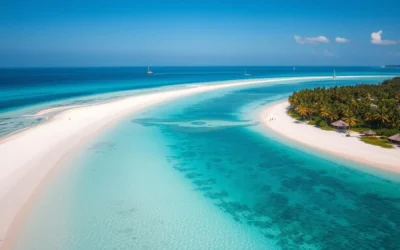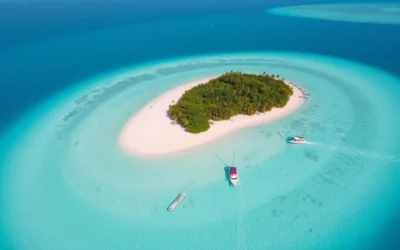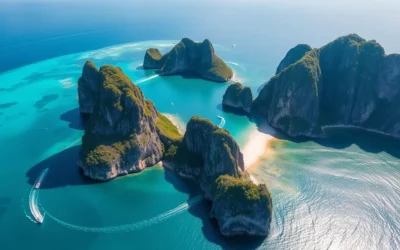✓ Accommodations✓ Flights✓ Rental Cars
Did you know the Banaue Rice Terraces are often called the “Eighth Wonder of the World” and were hand-carved by the indigenous Ifugao people over 2,000 years ago? These ancient agricultural marvels rise to an impressive 5,000 feet above sea level and would stretch 12,500 miles if placed end-to-end—nearly half the earth’s circumference! As you plan your journey to this remarkable UNESCO World Heritage site, prepare to be amazed by not just the terraces, but the rich cultural heritage and natural beauty that make Banaue one of the Philippines’ most treasured destinations.
Planning Your Journey to Banaue
Banaue is located in the Ifugao province of northern Luzon, approximately 350 kilometers north of Manila. While the journey requires some planning, the spectacular sights that await make every effort worthwhile. Here’s how to prepare for your adventure to this mountain paradise.
Ready to Experience Banaue?
Start planning your unforgettable journey to the ancient rice terraces today!
Getting to Banaue
The most common way to reach Banaue is by taking an overnight bus from Manila. Two major bus companies service this route:
- Ohayami Trans – Offers regular overnight trips departing around 10:00 PM, arriving in Banaue by 7:00 AM
- Coda Lines – Provides slightly more comfortable buses with toilet facilities for express journeys
The journey takes approximately 8-9 hours, with buses typically making brief stops for restroom breaks. Upon arrival in Banaue, you’ll stop at the tourism office to pay a small environmental fee (around ₱50) that helps maintain the area.

For those who prefer more flexibility, you can also:
- Rent a car from Manila (10-hour drive)
- Take a flight to Cauayan Airport in Isabela province, then travel by van or bus to Banaue (3-4 hours)
Best Time to Visit Banaue
The ideal time to visit Banaue is during the dry season from November to May, with December to February offering the coolest temperatures. Each season offers a different perspective of the rice terraces:
- December to February: Cool weather (15-20°C) with clear skies, perfect for trekking and photography
- March to May: Warmer temperatures with terraces transitioning from brown (planting season) to vibrant green
- June to August: Lush green terraces at their most photogenic, but with increased rainfall
- September to November: Harvest season with golden-yellow terraces, offering unique photo opportunities

For the best experience, try to avoid the peak of the rainy season (July to September) when heavy downpours can cause landslides and make trekking difficult. However, if you don’t mind occasional rain, this period offers fewer tourists and the most vibrant green terraces.
Local Tip: The last week of May through mid-June is considered by many locals to be the optimal time to visit, as this is when the rice terraces are at their greenest while still enjoying relatively good weather.
Getting Around Banaue
Navigating Banaue and its surrounding attractions requires some planning due to the mountainous terrain. Here are your main transportation options:
Jeepneys
These colorful public transportation vehicles run between Banaue town and nearby villages like Batad Saddle Point. They typically operate twice daily (morning and afternoon), but schedules can be irregular. A one-way trip costs around ₱150.
Tricycles
For shorter distances or when jeepneys aren’t available, motorized tricycles are convenient. They can accommodate 2-3 passengers and can be chartered for half-day or full-day tours. Expect to pay ₱1,000-2,000 for a day trip to nearby attractions.

Hiking
Many of Banaue’s attractions are best accessed on foot. The town center is walkable, but reaching the rice terraces and villages requires trekking along paths that can be steep and challenging. Proper footwear is essential.
Private Transport
For maximum flexibility, you can arrange a private vehicle with driver through your accommodation. This option is more expensive but allows you to create a customized itinerary.
Explore Banaue Your Way
Need a vehicle to explore the region at your own pace? Find the perfect rental car for your adventure.
Top Attractions in Banaue
Banaue offers a wealth of natural and cultural attractions that showcase the ingenuity and traditions of the Ifugao people. Here are the must-visit sites that should be on every traveler’s itinerary:

1. Batad Rice Terraces
The crown jewel of Banaue, these UNESCO-listed terraces form a perfect amphitheater around a small village. Their breathtaking beauty and engineering marvel status make them worth the challenging trek. The terraces have been preserved for over 2,000 years and offer the most dramatic views in the region.
Visitor Tip: Hire a local guide (₱200-300) to navigate the terraces safely and learn about Ifugao culture and farming practices.
Book a Guided Tour

2. Tappiyah Falls
This stunning waterfall is accessible via a trek through the Batad Rice Terraces. The 70-meter cascade creates a refreshing natural pool perfect for swimming after your hike. The journey takes about 2 hours from Batad village, with cemented steps making the path more accessible than in previous years.
Visitor Tip: Start your hike early (around 8:00 AM) to avoid crowds and have the falls mostly to yourself. Bring a change of clothes if you plan to swim.

3. Bangaan Rice Terraces
Another UNESCO World Heritage site, Bangaan offers a different perspective with its terraces surrounding a traditional village with authentic Ifugao houses called “bale.” This site is more accessible than Batad and can be viewed from the roadside viewpoint or explored up close with a short trek.
Visitor Tip: Visit the village to see demonstrations of traditional rice husking techniques and purchase handcrafted souvenirs directly from local artisans.

4. Banaue Viewpoint
Located along the highway just outside town, this convenient viewpoint offers spectacular panoramas of the rice terraces without requiring any hiking. There are actually four different viewing angles to appreciate the terraces from different perspectives.
Visitor Tip: Visit early morning when mist often creates a magical atmosphere as it rises from the terraces. Local vendors offer the opportunity to take photos in traditional Ifugao attire.

5. Hapao Rice Terraces
Less visited than Batad but equally impressive, the Hapao terraces feature a unique rectangular design with solid stone walls rising up to 20 feet. Located in Hungduan municipality, these terraces offer a more peaceful experience away from the tourist crowds.
Visitor Tip: Combine your visit with a stop at the nearby hot springs where you can soak your tired muscles after trekking.

6. Banaue Museum
This compact two-story museum houses an impressive collection of Ifugao artifacts gathered by anthropologist Henry Otley Beyer. It’s an excellent place to learn about the history, traditions, and craftsmanship of the Ifugao people before exploring the terraces.
Visitor Tip: The entrance fee is approximately ₱100, and the knowledgeable staff can provide additional insights about the exhibits. The museum also has a small souvenir shop with authentic crafts.
Experience Banaue’s Cultural Heritage
Discover the ancient traditions and breathtaking landscapes with expert local guides.
Browse Available Tours
Trekking Options in Banaue

Day Treks
For visitors with limited time, several excellent day trek options are available:
- Batad Rice Terraces Trek: A moderate 4-5 hour round trip from Batad Saddle Point to the village and viewpoints
- Tappiyah Falls Trek: A challenging 3-4 hour round trip from Batad village
- Bangaan Village Trek: An easier 2-3 hour exploration suitable for most fitness levels
- Hapao Rice Terraces and Hot Springs: A moderate 4-hour trek with a rewarding soak at the end
Multi-Day Treks
For more adventurous travelers, these extended treks offer deeper immersion:
- Heritage Trek: A 3-day journey covering Pula, Cambulo, Batad, and Bangaan villages
- Ifugao Cultural Trail: A 2-day trek focusing on traditional villages and cultural experiences
- Banaue to Sagada Trek: An ambitious 3-4 day trek connecting two major tourist destinations
Trekking Tip: Always hire a local guide for safety and cultural insights. Guides typically charge ₱1,000-1,500 per day depending on the route difficulty.
Ready for an Adventure?
Book a guided trekking tour with experienced local guides who know the terraces intimately.
Find Trekking Tours
Where to Stay in Banaue
Banaue offers a range of accommodation options from basic homestays to more comfortable hotels. Here are some recommended places to stay based on your preferences and budget:

Mid-Range Options
- Banaue Hotel & Youth Hostel: The area’s largest hotel offering comfortable rooms, a restaurant with panoramic views, and cultural performances
- Banaue Greenfields Inn & Restaurant: Located 1km from town center, offering peaceful surroundings and good connectivity
- Baleh Boble Guesthouse: Comfortable rooms with modern amenities and excellent service

Budget Accommodations
- Batad Transient House: Simple rooms with incredible views of the Batad terraces
- Ramon’s Homestay: Basic accommodation in Batad with friendly hosts and guide dogs
- Uyami’s Green View Lodge: Affordable rooms in town with a good restaurant and souvenir shop
- 7th Heaven’s Café & Lodging: Budget-friendly option with excellent food and helpful staff

Unique Stays
- Hiwang Native House Inn: Traditional Ifugao huts offering an authentic cultural experience
- Native Village Inn: Eco-friendly accommodation with traditional elements and modern comforts
- Batad View Inn: Stunning terrace views with basic but clean facilities
Accommodation Tip: Book in advance during peak season (December-February). Many accommodations in Batad have limited or no internet connectivity.
Find Your Perfect Stay in Banaue
From traditional huts to comfortable hotels, find the accommodation that suits your style and budget.
Local Cuisine and Dining

Traditional Ifugao Dishes
Sampling local cuisine is an essential part of experiencing Banaue’s culture. Don’t miss these traditional specialties:
- Pinikpikan: A ceremonial chicken dish prepared using a unique traditional method
- Dinakdakan: Grilled pork parts mixed with brain and liver sauce
- Tinawon Rice: The special heirloom rice variety grown on the terraces
- Tapuy: Traditional rice wine often served during celebrations
Where to Eat in Banaue
Banaue offers a variety of dining options from local eateries to restaurants catering to tourists:
- House of Ekolife: Offers excellent food with stunning views of the rice terraces. Try their sisig (₱200)
- Uyami’s Green View Lodge and Restaurant: Serves good local cuisine including their specialty Green View Express
- 7th Heaven Café: Popular for breakfast and coffee with mountain views
- Las Vegas Restaurant: Offers a mix of Filipino and international dishes
- Mother’s Eatery: Budget-friendly local carinderia with authentic Filipino dishes (₱40-50)
Dining Tip: The Saturday public market (7:00 AM – 10:00 AM) is an excellent place to purchase fresh organic produce, rice cakes, and local delicacies at very reasonable prices.
Cultural Experiences in Banaue

Traditional Crafts
The Ifugao people are renowned for their craftsmanship. Visitors can observe and participate in traditional craft demonstrations:
- Wood carving of bulul (rice guardian figures)
- Backstrap loom weaving of traditional textiles
- Basket weaving using native materials
Many shops in Banaue town offer authentic handcrafted souvenirs, with the best selection available at the Banaue Craft Market near the town center.
Cultural Performances
Several venues offer traditional dance and music performances:
- Banaue Hotel hosts weekly cultural shows featuring traditional dances
- During festivals, public performances take place in the town plaza
- Some villages offer private performances for visitors by arrangement
The performances typically showcase traditional Ifugao dances that tell stories of harvest, courtship, and warfare, accompanied by gong ensembles.
Homestay Experiences
For deep cultural immersion, consider a homestay with a local family:
- Learn traditional cooking methods
- Participate in daily activities like farming
- Listen to folk stories and legends
- Experience authentic Ifugao hospitality
The tourism office can help arrange homestay experiences with families in various villages around Banaue.
Immerse Yourself in Ifugao Culture
Book a cultural tour to experience traditional performances, crafts, and authentic local interactions.
Discover Cultural Tours
Practical Tips for Visiting Banaue
Essential Items to Pack
- Trekking shoes: Sturdy footwear with good grip is essential for navigating the terraces
- Rain gear: A lightweight poncho or jacket, as weather can change quickly
- Insect repellent: Particularly important during rainy season
- Sun protection: Hat, sunglasses, and sunscreen for clear days
- Light layers: Temperatures can vary significantly between day and night
- Trekking pole: Helpful for stability on steep paths
- Cash: ATMs are limited, so bring sufficient Philippine Pesos
Health and Safety
- Altitude adjustment: Banaue sits at approximately 1,500 meters elevation, so take it easy on your first day
- Water: Drink only bottled or purified water
- Medical supplies: Bring basic first aid items as medical facilities are limited
- Travel insurance: Recommended for emergency evacuation coverage
- Guides: Always hire local guides for treks to ensure safety and support the local economy
- Road conditions: Be prepared for winding mountain roads that can cause motion sickness
Communication
- Internet: Available in Banaue town but limited or non-existent in outlying villages like Batad
- Mobile service: Globe and Smart have coverage in town, but signal is spotty in remote areas
- Language: English is widely spoken, especially by those working in tourism
- Local contacts: Save your accommodation and guide phone numbers before heading to areas with no signal
Etiquette and Respect
- Ask permission: Before photographing locals, especially elders
- Dress modestly: When visiting villages and cultural sites
- Remove shoes: When entering traditional Ifugao homes
- Speak softly: Especially when trekking through villages
- Support local: Purchase souvenirs directly from artisans when possible
- Environmental respect: Carry out all trash and stay on designated paths
Pro Tip: If staying in Batad, consider leaving your large luggage at your accommodation in Banaue town and only bringing essentials for your village stay. Many accommodations offer luggage storage for this purpose.
Sample Itineraries for Banaue
1-Day Express Itinerary
For travelers with very limited time:
- Arrive in Banaue early morning (overnight bus from Manila)
- Visit Banaue Viewpoint for panoramic views of the terraces
- Take a jeepney or tricycle to Batad Saddle Point
- Trek to Batad village and rice terraces (2 hours)
- Enjoy lunch at a local restaurant in Batad
- Return to Banaue town by late afternoon
- Visit the Banaue Museum
- Dinner at Uyami’s Green View Lodge
- Depart Banaue in the evening
3-Day Comprehensive Itinerary
For a more relaxed exploration:
Day 1:
- Arrive in Banaue morning (overnight bus from Manila)
- Check into accommodation in Banaue town
- Visit Banaue Museum to learn about Ifugao culture
- Explore Banaue town and local craft shops
- Visit Banaue Viewpoint for sunset views
Day 2:
- Early morning jeepney to Batad Saddle Point
- Trek to Batad village and rice terraces
- Continue to Tappiyah Falls for swimming
- Overnight stay in Batad village homestay
Day 3:
- Morning trek back to Batad Saddle Point
- Visit Bangaan Rice Terraces
- Explore Hapao Rice Terraces and hot springs
- Return to Banaue for evening departure
Create Your Perfect Banaue Adventure
Ready to experience the ancient rice terraces and rich cultural heritage of Banaue?
Browse Accommodations
Explore Tours
Map of Banaue
Banaue is located in the Ifugao province of northern Luzon, approximately 350 kilometers north of Manila.
Experience the Wonder of Banaue
The ancient rice terraces of Banaue stand as a testament to human ingenuity and harmony with nature, offering visitors a glimpse into a way of life that has remained largely unchanged for centuries. As you trek along the narrow paths winding through these magnificent agricultural marvels, you’ll not only witness breathtaking landscapes but also experience the warm hospitality and rich cultural heritage of the Ifugao people. Whether you’re capturing the perfect sunrise over the terraced mountains, cooling off in the refreshing waters of Tappiyah Falls, or learning traditional crafts from local artisans, Banaue promises memories that will last a lifetime. The journey may require some effort, but as countless travelers before you have discovered, the rewards of experiencing this “Eighth Wonder of the World” are immeasurable. Pack your hiking boots and sense of adventure—Banaue’s ancient terraces and timeless traditions await your discovery.
Ready to Experience Banaue?
Start planning your unforgettable journey to the ancient rice terraces today!
—
The above is subject to change.
Check back often to TRAVEL.COM for the latest travel tips and deals.










